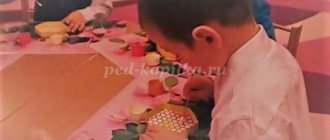Educational field "Communication" (secondary group)
| Levels | Didactic games, exercises, questions | Criteria for evaluation |
| I. Level of vocabulary development | 1 Game “Describe the object.” Material: various subject pictures. Contents of the diagnostic task: The teacher shows one picture at a time, for example: a ball, a hat, a bucket, flowers. Asks to answer the questions: - What is this? (Ball.) - What is he like? (Red, big, airy.) - What can you do with it? (Play, roll on the floor, throw, kick.) 2 Didactic game “Finish the sentence.” Contents of the diagnostic task: The teacher invites the child to play the game “Finish the sentence.” “I’ll start the sentence, and you think about how you can finish it.” - Sugar is sweet, and pepper... (bitter). - The road is wide, but the path... (narrow). - Plasticine is soft, and stone... (hard). - The stepmother is evil, and Cinderella... - Karabas-Barabas is evil, and Papa Carlo... etc. | 1 point - poor vocabulary, difficulty in choosing antonyms. 2 points - understands and uses antonym words. Makes mistakes or finds it difficult to determine the various properties and qualities of objects, aesthetic characteristics. 3 points - the child actively uses words denoting emotional states (angry, sad), ethical qualities (cunning, kind), and aesthetic characteristics. |
| I. Level of vocabulary development | 3. Task “Tell me about the boys.” Material: plot picture depicting two boys: one is clean, neat, cheerful, the second is sloppy, sad. Contents of the diagnostic task: The teacher asks the child to look at a picture of two boys. Then he organizes a conversation on the following questions: - What can you say about boys? Are they in the same mood? - One boy is cheerful, but what about the other? (Sad.) - Is it good to be sloppy? - What should you do to be clean and tidy? - Which boy do you like? Why? And so on. | |
| II. Level of formation of the grammatical aspect of speech | 1. Didactic exercise “Setting the table.” Material: tea set (For dolls), object pictures depicting food products (models). Contents of the diagnostic task: The teacher offers to look at the dishes and answer questions. - How can you name all the objects? (Draws attention to the tea set.) Name famous pieces of utensils. — What products are needed to treat a person to tea? (Sugar, tea, crackers...) - Which bowl should I put the sugar in? (Into the sugar bowl.) - And what about the crackers? (Into the rusk bowl.) Etc. - Arrange the dishes beautifully. -Where is the teaspoon? (Next to the saucer or to the right of the saucer.) Etc. 2. Exercise “Complete the sentence.” Contents of the diagnostic task: The teacher asks the child to come up with the ending of the sentence: “Night came and...” “Mom and I went to the store and bought...”. “I like winter because...” “We are doing exercises because...” Etc. 3. Didactic game “Hide and Seek.” Material: sets of toy animals (bear cubs, kittens, hedgehogs, foxes) or object pictures with their image. Contents of the diagnostic task: The teacher arranges toys (lays out pictures) and asks the child to name groups of animals. - These are fox cubs. - These are hedgehogs. Etc. Then the teacher asks to remember all groups of animals and invites the child to close his eyes. The teacher removes one group of toys. After the child opens his eyes, the teacher asks to name who is missing (bear cubs, kittens, etc.). | 1 point - the child cannot cope with the tasks. 2 points - it is difficult to independently form new words (sugar - sugar bowl), comprehends cause-and-effect relationships, mainly uses simple or complex sentences in speech, excluding complex sentences. Makes mistakes in forming the plural of nouns denoting animals. 3 points - the child forms new words by analogy with already familiar ones. Understands and uses prepositions in speech. Comprehends cause-and-effect relationships and composes complex, complex sentences. Correctly forms the plural form of nouns denoting baby animals. |
| III. Level of development of coherent speech | 1. Didactic game “The postman came to us.” Material: plot pictures “Seasons”. Contents of the diagnostic task: 4 children can participate in the game. The teacher selects postcards with a simple plot, but in such a way that it is clear what time of year the action takes place. The teacher reports that the postman brought postcards to all the children. Once children receive a postcard, they should not show it to each other. It is necessary to tell the plot in such a way that it is clear what time of year the action takes place. 2. Didactic game “Tell me about the toy.” Material: a set of different toys: a car, a ball, a doll, a bunny, etc. Contents of the diagnostic task: The teacher shows the toys and offers a sample story about one of them. Repeats it again, paying attention to the plan of the descriptive story. Then he offers to describe any of the toys according to the same plan. 3. Dramatization of the fairy tale “The Cockerel and the Bean Seed.” Contents of the diagnostic task: The teacher takes out a chicken, a cockerel, and a bean seed from a fairy chest. - What fairy tale do these heroes come from? - What happened to the cockerel? - Why do you think the cockerel choked? — Who did the chicken run to first for help? — What was the butter needed for? (A brief conversation is held about the fairy tale in order to remember its content.) Then the teacher invites the child to act out the fairy tale using the present. theater | 1 point - the child cannot, even with the help of an adult, talk about the content of the plot picture. Not able to describe a toy based on a model. When dramatizing a fairy tale, he mainly uses situational speech and gestures. 2 points - the child composes a story using leading questions. There are isolated cases of violation of the sequence in the description of signs. With the help of an adult, he dramatizes a familiar fairy tale. 3 points - the child talks in detail about the content of the plot picture, consistently writes a story about the toy. Knows how to dramatize passages from a familiar fairy tale. |
| IV. Sound culture of speech. | Didactic exercise “Identify the first sound in a word.” Contents of the diagnostic task: The teacher suggests playing with words. Asks the child to listen carefully as he identifies the first sound with his voice. OOO-la, AAA-stra, UUU-tka, etc. When repeating words, he asks to name the first sound. | 1 point – pronounces a large number of sounds with distortion, making it difficult to identify the first sound. 2 points - does not pronounce all sounds clearly, emphasizes the first sound. 3 points - meaningfully works on his own pronunciation, emphasizing the first sound in a word. High level 10-12 points Average level - 6-9 points Low level - 4-5 points. |
"From birth to school."
Basic general education program for preschool education / Ed. NOT. Veraksy, T.S. Komarova, M.A. Vasilyeva



